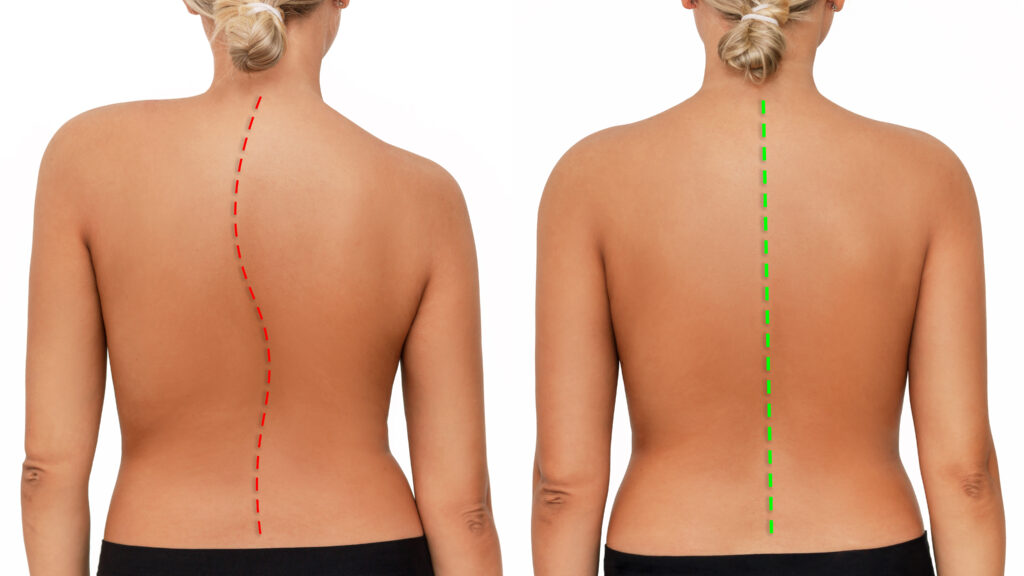If you're struggling with lower back pain, you're not alone, and finding relief is possible with some simple adjustments. By focusing on your posture and incorporating stretches into your daily routine, you can start to ease discomfort quickly. Staying active is essential, but understanding the right activities can make a significant difference. Exploring effective strategies, like heat therapy and ergonomic solutions, can further enhance your recovery. So, what are the best practices to implement today for lasting relief? Let's uncover some actionable tips that could transform how you feel.
Practice Good Posture
One key to preventing lower back pain is practicing good posture. When you sit, stand, or move, being mindful of your body alignment can make a considerable difference in how your back feels.
Start by sitting up straight in your chair, keeping your feet flat on the floor and your knees at a 90-degree angle. Your back should be against the chair, and your shoulders relaxed but not slumped. If you spend long hours at a desk, consider using a chair that supports your lower back.
When standing, distribute your weight evenly on both feet, and avoid locking your knees. Engage your core muscles to help support your spine. This simple adjustment can help reduce strain and prevent discomfort. If you're carrying a bag or backpack, switch sides regularly to keep your body balanced.
In addition to sitting and standing, pay attention to your posture while walking. Keep your head up, shoulders back, and avoid leaning forward. Good posture not only prevents pain but can also improve your overall confidence and presence.
If you're lifting objects, bend at your knees instead of your waist. Keep the item close to your body and use your legs to lift, not your back.
Stretch Regularly
Stretching regularly is essential for maintaining flexibility and preventing lower back pain.
By incorporating effective stretching techniques into your routine, you can improve your range of motion and reduce tension in your muscles.
Let's explore some simple stretches that can make a big difference in your comfort and mobility.
Importance of Flexibility
Flexibility plays an essential role in preventing and alleviating lower back pain. When your muscles and joints are flexible, they can move more freely, reducing the strain on your lower back. Tight muscles can pull on your spine, leading to discomfort and pain. By incorporating flexibility exercises into your routine, you can help maintain a healthy range of motion, which is vital for avoiding injury.
Regular stretching not only increases flexibility but can also improve blood flow to your muscles. This enhanced circulation helps to keep your muscles nourished and promotes quicker recovery after physical activities. When you take the time to stretch, you're giving your body the chance to relax and release tension, which can be particularly beneficial after a long day of sitting or standing.
Don't underestimate the power of flexibility in your daily life. As you work on becoming more flexible, you'll likely notice improvements in your posture and overall mobility. This can help reduce the risk of future back pain episodes.
Whether it's a gentle yoga session or simple stretches during breaks, prioritizing flexibility is a significant step in managing and preventing lower back pain.
Effective Stretching Techniques
Incorporating effective stretching techniques into your daily routine can make a significant difference in preventing lower back pain. Start with simple stretches that target the muscles in your back, hips, and legs.
For instance, try the cat-cow stretch to improve flexibility and relieve tension. Begin on all fours, arch your back up like a cat, then dip it down like a cow. Repeat this for 10 repetitions.
Next, consider the seated forward bend. Sit with your legs extended, and slowly reach for your toes. Hold this position for 20-30 seconds while breathing deeply. This helps elongate your spine and stretch your hamstrings.
Another great option is the child's pose. Kneel on the floor, sit back on your heels, and stretch your arms forward while lowering your torso. Hold for 30 seconds to release tension in your lower back.
Make sure you stretch daily, especially after prolonged periods of sitting or standing. Even just 5-10 minutes can help you maintain flexibility and reduce discomfort.
Listen to your body, and never push yourself too far—gentle stretching is key to easing and preventing pain.
Use Heat Therapy
Using heat therapy can provide you with significant relief from lower back pain.
There are various heat sources available, like heating pads and warm towels, that can ease tension and improve circulation.
You'll also find effective application techniques that maximize the benefits of heat for your back.
Benefits of Heat Therapy
Have you ever wondered how heat therapy can ease your lower back pain? This simple yet effective treatment can provide significant relief by increasing blood flow to the affected area.
When you apply heat, it helps relax tight muscles, reducing stiffness and discomfort. You might find that this warmth not only soothes pain but also improves your overall mobility.
Another benefit of heat therapy is its ability to promote the healing process. Increased circulation allows essential nutrients and oxygen to reach damaged tissues, speeding up recovery.
You'll likely notice that using heat regularly can contribute to long-term relief, making it easier to manage daily activities.
Heat therapy is also easy to incorporate into your routine. Whether you prefer a heating pad, hot water bottle, or warm towel, you can enjoy the comfort of heat therapy in just a few minutes.
Just make sure you don't apply heat for too long to avoid burns.
Types of Heat Sources
When it comes to heat therapy for lower back pain, there are several effective heat sources you can choose from. One popular option is a heating pad. These pads provide consistent heat and can be easily adjusted to your comfort level. You can use them while sitting or lying down, making them versatile for your daily routine.
Another great choice is a hot water bottle. Simply fill it with warm water, and you've got a portable heat source. You can place it directly on your lower back for targeted relief.
If you prefer something more natural, a warm towel or blanket can work wonders. Just soak the towel in warm water, wring it out, and apply it to the affected area.
For a more immersive experience, consider taking a warm bath. The heat from the water soothes your muscles and promotes relaxation.
Finally, if you're on the go, heat wraps designed for lower back pain can provide discreet relief throughout your day. By selecting the right heat source, you can effectively ease your lower back pain and improve your comfort.
Application Techniques for Relief
Applying heat therapy effectively can markedly enhance your relief from lower back pain. The right techniques can make all the difference in your comfort. Here's how to apply heat for the best results:
- Choose the Right Source: Whether it's a heating pad, hot water bottle, or microwaveable rice bag, select a source that's convenient and safe.
- Time It Right: Apply heat for 15-20 minutes at a time. This duration helps relax muscles without risking burns or irritation.
- Keep It Comfortable: Always place a cloth between the heat source and your skin to prevent burns. Make sure it feels warm, not scorching.
- Frequency Matters: Use heat therapy several times a day, especially after periods of inactivity. This can relieve tension and improve blood circulation.
Incorporating these techniques into your routine can lead to significant relief.
Stay Active
Staying active is crucial for managing lower back pain effectively. When you keep moving, it helps maintain flexibility and strength in your back and surrounding muscles. You might think resting is the best way to alleviate pain, but prolonged inactivity can actually worsen your condition. Instead, focus on incorporating gentle movements into your daily routine.
Consider activities like walking, swimming, or cycling. These low-impact exercises keep your body engaged without putting too much strain on your back. Aim for at least 30 minutes of activity most days of the week. If you're unsure where to start, try taking short walks around your neighborhood or joining a local fitness class designed for people with back pain.
Listen to your body and don't push through severe pain. If you feel discomfort, scale back the intensity or duration of your activities. Gradually increasing your activity level can lead to long-term benefits.
Stretching is another crucial component of staying active. Simple stretches can improve your flexibility and relieve tension in your back. Incorporate stretches into your routine, especially after extended periods of sitting or standing.
Finally, remember that consistency is key. Staying active isn't just a one-time effort; it's about making movement a regular part of your life. By prioritizing activity, you'll likely find that your lower back pain becomes more manageable, allowing you to enjoy your daily activities with greater ease and comfort.
Strengthen Core Muscles
Building strength in your core muscles plays a crucial role in relieving lower back pain. A strong core supports your spine, stabilizes your pelvis, and helps maintain proper posture.
When your core is weak, it can lead to an imbalance that places extra strain on your lower back. Fortunately, strengthening your core doesn't have to be complicated. Here are some effective exercises you can do to build core strength:
- Plank: Hold your body in a straight line from head to heels, resting on your forearms and toes. Aim for 30 seconds to start, gradually increasing your time as you get stronger.
- Bird-Dog: While on your hands and knees, extend one arm forward and the opposite leg back. Hold for a few seconds before switching sides. This exercise enhances balance and coordination.
- Dead Bug: Lie on your back with your arms in the air and knees bent at a 90-degree angle. Slowly lower one arm and the opposite leg toward the ground, then return to the starting position. Alternate sides for a solid core workout.
- Bridge: Lie on your back with your knees bent and feet flat on the floor. Lift your hips toward the ceiling, engaging your glutes and core. Hold for a few seconds before lowering back down.
Incorporating these exercises into your routine can greatly strengthen your core, ultimately helping you relieve lower back pain and improve your overall stability.
Start today, and you'll feel the difference!
Consider Ergonomic Solutions
When it comes to relieving lower back pain, considering ergonomic solutions can make a significant difference in your daily comfort. You spend a lot of time sitting, whether at work or home, and your workspace setup can greatly impact your back health.
Start by evaluating your chair. It should support your lower back, allowing you to sit with your feet flat on the floor and knees at a 90-degree angle. If your chair isn't ergonomic, investing in one that's adjustable can help you maintain proper posture throughout the day.
Next, check your desk height. Your computer screen should be at eye level, so you don't strain your neck or back while working. If necessary, use a monitor stand or an adjustable desk to find the right height.
Additionally, consider using a keyboard and mouse that promote a natural wrist position, which can reduce strain on your back and arms.
Don't forget about your habits. Take regular breaks to stand, stretch, or walk around. Incorporate these short breaks into your routine to prevent stiffness.
You might also want to explore using a standing desk or a balance ball chair to engage your core muscles while working.
Lastly, if you're on the phone often, try using a headset instead of cradling the phone between your ear and shoulder. These small adjustments can lead to significant improvements in your comfort and help alleviate lower back pain over time.
Prioritizing ergonomics is an essential step toward feeling better every day.
Seek Professional Help
Seeking professional help is often a crucial step in managing lower back pain effectively. While self-care strategies can provide relief, sometimes you need expert guidance to address the underlying issues.
Here's what you should consider when seeking help:
- Consult a Healthcare Provider: Start with your primary care doctor. They can evaluate your condition and refer you to a specialist if necessary.
- Physical Therapy: A physical therapist can design a personalized exercise program that targets your specific pain areas, helping you strengthen and stabilize your back.
- Chiropractic Care: Chiropractors focus on spinal alignment and may offer adjustments that alleviate pain and improve mobility.
- Pain Management Specialists: If your pain persists, a pain management specialist can explore advanced treatment options, like injections or medications.
Don't hesitate to reach out for help. Lower back pain can stem from various causes, and a professional can diagnose the issue accurately.
They'll provide tailored recommendations based on your unique situation, which can lead to a more effective recovery plan.
Remember, your health is worth investing in, and seeking professional help may fast-track your journey to feeling better.
Don't let pain dictate your life—take control and get the support you need!
Conclusion
By following these tips, you can take charge of your lower back pain today. Focus on maintaining good posture, stretching regularly, and staying active to keep your back healthy. Don't forget to use heat therapy for relaxation and consider ergonomic solutions to improve your workspace. If your pain persists, seeking professional help can provide personalized strategies for relief. Remember, small changes can lead to significant improvements in your overall well-being. Start today for a healthier back!



